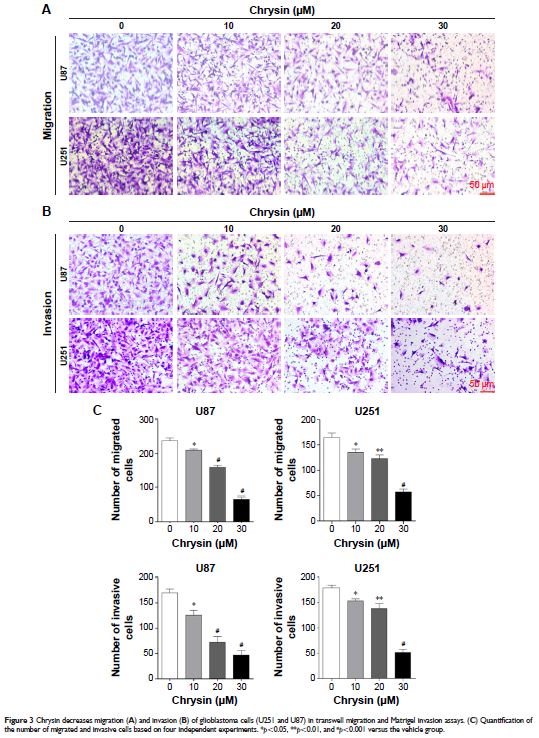108985
论文已发表
注册即可获取德孚的最新动态
IF 收录期刊
- 3.4 Breast Cancer (Dove Med Press)
- 3.2 Clin Epidemiol
- 2.6 Cancer Manag Res
- 2.9 Infect Drug Resist
- 3.7 Clin Interv Aging
- 5.1 Drug Des Dev Ther
- 3.1 Int J Chronic Obstr
- 6.6 Int J Nanomed
- 2.6 Int J Women's Health
- 2.9 Neuropsych Dis Treat
- 2.8 OncoTargets Ther
- 2.0 Patient Prefer Adher
- 2.2 Ther Clin Risk Manag
- 2.5 J Pain Res
- 3.0 Diabet Metab Synd Ob
- 3.2 Psychol Res Behav Ma
- 3.4 Nat Sci Sleep
- 1.8 Pharmgenomics Pers Med
- 2.0 Risk Manag Healthc Policy
- 4.1 J Inflamm Res
- 2.0 Int J Gen Med
- 3.4 J Hepatocell Carcinoma
- 3.0 J Asthma Allergy
- 2.2 Clin Cosmet Investig Dermatol
- 2.4 J Multidiscip Healthc

Chrysin 通过介导 ERK/Nrf2 信号通路抑制成胶质细胞瘤细胞系中的增殖、迁移和侵袭
Authors Wang J, Wang HD, Sun KJ, Wang XL, Pan H, Zhu JH, Ji XJ, Li X
Received 16 December 2017
Accepted for publication 16 February 2018
Published 3 April 2018 Volume 2018:12 Pages 721—733
DOI https://doi.org/10.2147/DDDT.S160020
Checked for plagiarism Yes
Review by Single-blind
Peer reviewers approved by Dr Palas Chanda
Peer reviewer comments 2
Editor who approved publication: Dr Anastasios Lymperopoulos
Background: Chrysin, an active natural bioflavonoid, has been proven to
protect against carcinogenesis. However, the role of chrysin in glioblastoma
and the potential molecular mechanisms remain to be elucidated. In our previous
study, we found that nuclear factor erythroid 2 (NF-E2)-related factor 2 (Nrf2)
is highly expressed in a variety of glioblastoma cell lines associated with the
mitogen-activated protein kinase (MAPK) pathway. The aim of this study was to
evaluate the antitumor effects of chrysin in glioblastoma cells and how chrysin
is related to the MAPK/Nrf2 signaling pathway.
Methods: A Cell Counting Kit-8 assay and a plate colony
formation assay were performed to evaluate cell proliferation. Cell migration ability
was tested by a wound-healing assay. Transwell migration and Matrigel invasion
assay were used to test the migration and invasion potential of cells. Nrf2 was
knocked down by shRNA transfection. Protein expression was determined by
Western blotting and immunofluorescence staining. The in vivo anticancer effect
was measured using tumor xenografts in nude mice.
Results: Chrysin inhibited the proliferation, migration, and
invasion capacity of glioblastoma cells in dose- and time-dependent manners.
Mechanistically, chrysin deactivated the Nrf2 signaling pathway by decreasing
the translocation of Nrf2 into the nucleus and suppressing the expression of
hemeoxygenase-1 (HO-1) and NAD(P)H quinine oxidoreductase-1, meanwhile, Nrf2
shRNA attenuated the anticancer activity of chrysin. Furthermore, chrysin
downregulated the protein expression of p-extracellular signal-regulated kinase
1 and 2 (ERK1/2), but did not significantly affect p-JNK and p-P38 expression
levels. However, the downregulated level of Nrf2 and the antitumor effect of
chrysin in glioblastoma cell lines were partially abrogated by the ERK1/2
signaling inhibitor (U0126). Finally, chrysin inhibited tumor growth in U87
xenografts.
Conclusion: Our results show that chrysin exerts anticancer
activity in glioblastoma cell lines possibly via the ERK/Nrf2 signaling pathway
and indicate the potential application of chrysin as a natural sensitizer in
chemotherapy.
Keywords: chrysin,
glioblastoma, nuclear factor erythroid 2-related factor 2, Nrf2, extracellular
signal-regulated kinase, ERK
